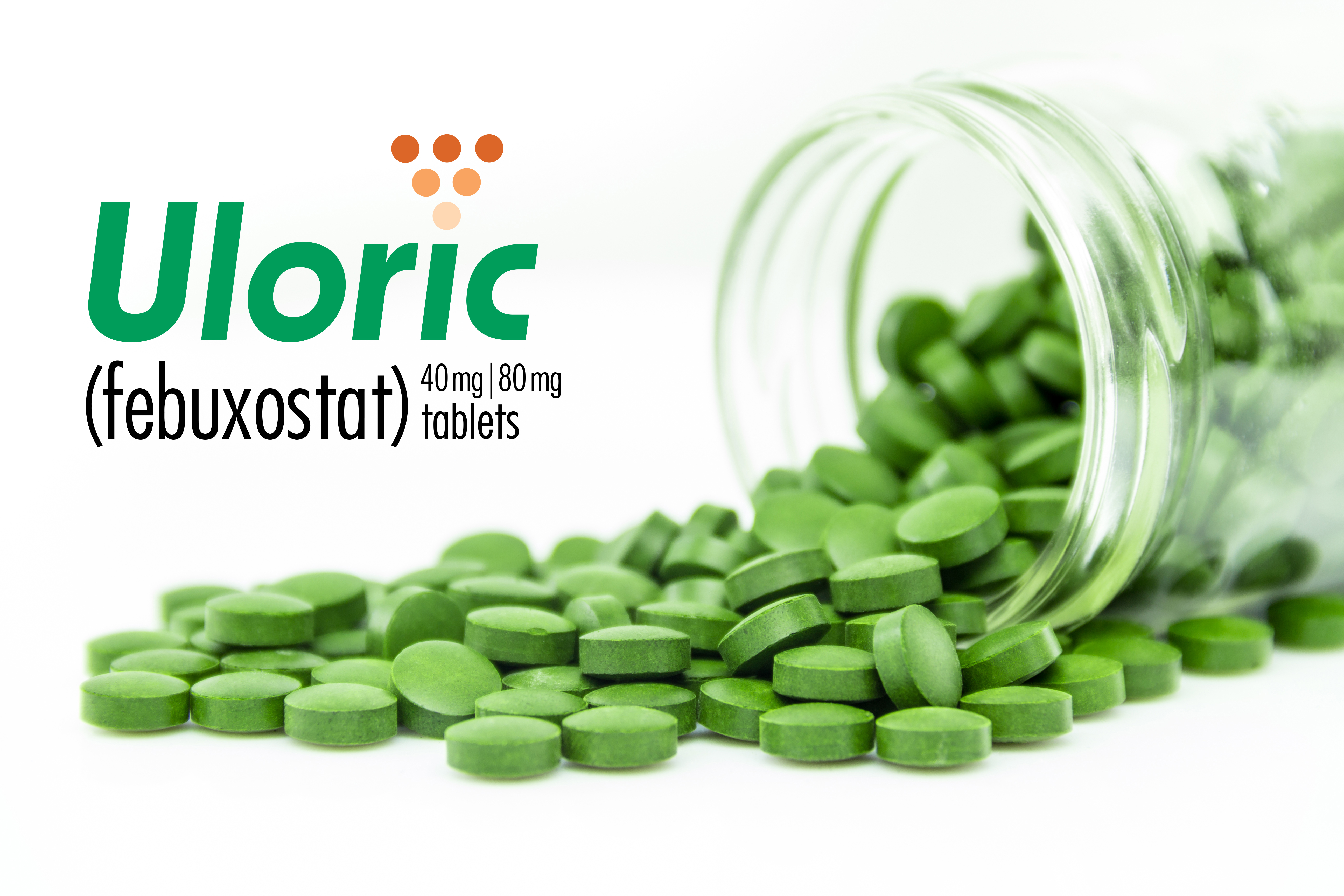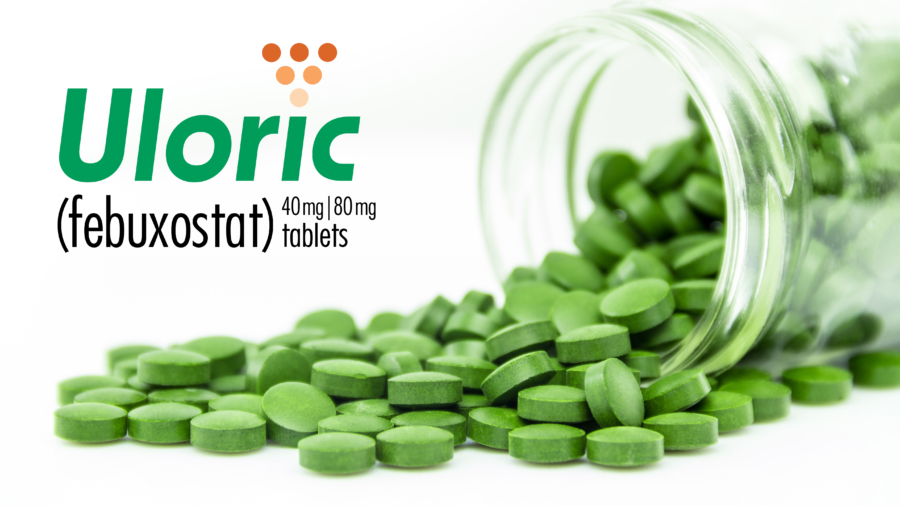In 2009, Uloric (febuxostat) was the first new drug approved by the FDA for gout in nearly 40 years. Until then, allopurinol (Zyloprim) was the only drug available on the market for preventing the formation of the uric acid crystals that cause gout. However, many patients could not tolerate the recommended therapeutic dose of allopurinol without suffering side effects (sometimes fatal). This new drug did not get overwhelming support by the FDA advisory committee but was ultimately approved.
Clinical Trials for Uloric
Early clinical trials of Uloric showed that at a dose of 80mg, this new drug worked far better than allopurinol and at a 40mg dose, it works equally as well as allopurinol (Clinical Trials, 2005) (Clinical Trials, 2009). Research findings on this drug were submitted with an application to the FDA for approval. The FDA rejected this application sighting that there were slightly more deaths and heart problems with patients taking Uloric than were reported with patients taking allopurinol.
The manufacturer (Takeda) then submitted another application for approval. This 2006 application was denied as well. The committee members noted that 9 of the total 12 deaths among Uloric subjects were attributable to cardiovascular events, whereas no serious adverse cardiovascular (CV) events were linked to allopurinol or the placebo. Taketa then conducted another clinical trial and did not find these same results (Schumacher et al., 2008). They reported that most common side effects seen in these patients were liver function abnormalities, muscle and connective-tissue symptoms, nausea, and rash (FDA Prescribing Info, 2009). The drug was reported as being well tolerated, and the side effects did not increase over long-term use.
The FDA grouped the finding from all of the studies conducted by Takeda and could not determine “with much confidence” that Uloric posed a greater risk of CV events than did allopurinol. They ultimately approved the use of Uloric in the chronic management of hyperuricemia (elevated levels of uric acid) in patients with gout. With this use granted, they also stipulated that the manufacturer (Takeda) was required to conduct additional post-marketing clinical trial to determine:
- Whether the use of Uloric is associated with a moderate increase in the risk of serious adverse cardiovascular outcomes when compared to allopurinol.
- Any drug-drug interactions with Uloric and a single, oral dose of theophylline.
The results of these clinical trials also needed to be reported to the FDA according to a set schedule. The Final Report Submission for the drug-drug interaction with theophylline was due on May 31, 2010, and the Final Report Submission for cardiovascular risks was due on January 31, 2015 (FDA, 2009). They were also required to include drug warning labels.


Uloric Marketing
According to a report in The Pharma Letter, in the decade since Uloric was approved, the medication has been aggressively marketed to consumers and providers (Pharma Letter, 2018). Takeda reported $1.9 billion in US sales of febuxostat from fiscal years 2012 through 2017. For the one-year period ending in June 2015, there were 1.3 million US prescriptions for Uloric, making it the 46th most prescribed brand-name medication in the USA at the time. The retail price of a 30-day supply of Uloric is also roughly 20-25 times higher than allopurinol when compared on the GoodRx website (3/2019).
Uloric Cardiovascular Concerns
In 2017, serious concerns started to surface about the CV risks associated with the use of Uloric. November of that year, the FDA announced that they had received the preliminary results from the required clinical trials from Takeda and were alerting the public that they showed an increased risk of heart-related death with febuxostat (Uloric) compared to allopurinol. They stated that once the Final Report Submission was received, the information would undergo a comprehensive review. Once that was complete, they would notify the public of any additional findings (FDA, 2017).
The results of the study known as CARES was presented in March 2018, at an annual meeting of the American College of Cardiology in Orlando. This long term study compared the risk of CV events with the use of Uloric to allopurinol. They concluded that the rates were comparable for major CV events (non-fatal heart attack, stroke, rhythm problems and hospitalization for heart failure) between the two drugs (American College of Cardiology, 2018).
Following this announcement, a nonprofit consumer advocacy organization called Public Citizen Health Research Group petitioned the FDA to remove the gout medication Uloric. According to the agency’s director “The FDA almost certainly would have denied approval of febuxostat if data from this post-market trial had been available at the time of the initial submission. The only justifiable course of action to prevent further cardiovascular deaths is obvious: This medication must be removed from the U.S. market immediately.”( Public Citizen, 2018)
In February 2019, the FDA released the results of their advisory committee review. The committee members overwhelmingly voted 19 to 2 (with one abstention) to approve a Boxed Warning for Uloric due to increased risk of heart-related death and death from all causes with the use of this drug. The FDA also stated that providers should “reserve Uloric for use only in patients who have failed or do not tolerate allopurinol. Counsel patients about the cardiovascular risk with Uloric and advise them to seek medical attention immediately if they experience the symptoms” such as:
- Chest pain
- Shortness of breath
- Rapid or irregular heartbeat
- Numbness or weakness on one side of your body
- Dizziness
- Trouble talking
- Sudden severe headache
Taketa’s View of the CV Risks of Uloric
Taketa’s most recent clinical study of Uloric revealed that there were 15 deaths per year from heart-related causes and 26 deaths per year from any cause per 1,000 patients were observed (FDA, 2019). The president of Takeda responded to the FDA announcement in January 2019 by saying “We have studied the safety of Uloric for more than 15 years and remain confident in Uloric as an important option for the chronic management of hyperuricemia in gout. We look forward to additional discussions with the FDA regarding these CARES data.”
Since the risk of CV events is increased in patients with gout, it is troubling to know that Takeda presented report after report of the findings of their drug Uloric, stating that there was a risk of adverse effects that include CV events. Despite this information and additionally required clinical trials, they aggressively marketed this drug to providers and to consumers that were already at risk. This led to hundreds of thousands of patients being prescribed the drug, who were unaware of the potential dangers associated with it.
Sources:
https://clinicaltrials.gov/ct2/show/NCT00102440
https://onlinelibrary.wiley.com/doi/full/10.1002/art.24209
https://www.accessdata.fda.gov/drugsatfda_docs/nda/2009/021856s000_Approv.pdf
https://www.accessdata.fda.gov/drugsatfda_docs/label/2017/021856s011lbl.pdf
https://worldhistoryproject.org/2009/2/13/fda-approves-takeda-pharms-uloric
https://www.medicinenet.com/script/main/art.asp?articlekey=94500
https://www.medscape.com/viewarticle/898600
https://www.webmd.com/arthritis/news/20090216/fda-oks-new-gout-drug-uloric
https://www.accessdata.fda.gov/drugsatfda_docs/nda/2009/021856s000TOC.cfm
https://clinicaltrials.gov/ct2/show/results/NCT00174915?view=results
https://www.fda.gov/downloads/drugs/drugsafety/ucm584803.pdf

Tracy R Everhart, MSN, MS CAM
For more than 20 years I've had the opportunity to work in numerous rolls within the medical field, including the last 7 years as a professional medical writer. With an undergraduate degree in biology/microbiology, postgraduate education in allopathic and complementary alternative medicine, my education has afforded me career opportunities with direct patient care, medical research and clinical oversight of statewide projects to improve the health of patients of all ages. I have a broad and deep knowledge of illnesses and conditions that can affect the human body. Even more important is that I have learned traditional treatment methodologies combined with alternative forms, to make the most informed decision about options that may be available.

Get A Free UloricCase Review
If you or someone you love has experienced health complications, including possible cardiovascular issues, while taking Uloric, you may have legal recourse to recover damages.


